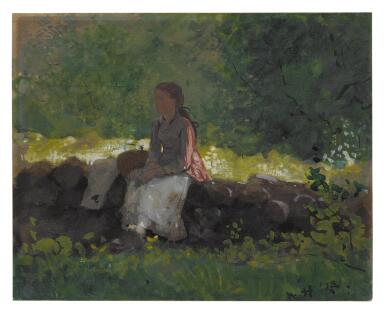
Property from a Private Collection, Washington, D.C.
WINSLOW HOMER | ON THE FENCE
Lot Closed
March 5, 07:32 PM GMT
Estimate
120,000 - 180,000 USD
Lot Details
Description
Property from a Private Collection, Washington, D.C.
WINSLOW HOMER
1836 - 1910
ON THE FENCE
signed with initials WH and dated '78 (lower right)
watercolor, gouache and pencil on paper laid down on card
6 ⅝ by 8 ½ inches
(16.8 by 21.6 cm)
Horace Hughes
F.W. Bayley & Son, Boston, Massachusetts
William Howe Downes, Boston, Massachusetts, 1910 (acquired from the above)
Alfred B. Downes, Boston, Massachusetts (by descent; sold: Sotheby's, New York, October 19, 1972, lot 13)
Acquired by the present owner at the above sale
Boston, Massachusetts, Museum of Fine Arts, Loan Exhibition of Paintings by Winslow Homer, February-March 1911
"The Water-Color Exhibition. List of Pictures Already Sold," Evening Post, New York, February 6, 1879, n.p.
"Art Notes," Sun, New York, February 10, 1879, n.p.
"Close of the Exhibition of the Water Color Society–A Most Successful Season," New York Herald, March 2, 1879, n.p.
William Howe Downes, The Life and Works of Winslow Homer, Cambridge, Massachusetts, 1911, p. 92, illustrated op. 118
Lloyd Goodrich and Abigail Booth Gerdts, Record of Works by Winslow Homer: 1877 to March 1881, vol. III, New York, 2008, no. 679, p. 118, illustrated
On the Fence is among a series of watercolors and drawings that Winslow Homer produced between 1877 and 1879 while living and working at Houghton Farm. Nestled in the Hudson River Valley town of Mountainville, New York, Houghton Farm belonged to Lawson Valentine, a varnish manufacturer, who was a principal patron and childhood friend of the artist. Homer first visited the property during the summer of 1876 and was immediately enchanted by the land's idyllic pastoral scenery. Initiating Homer’s mature period, over the next three summers the farm served as inspiration for an extensive and distinct body of work.
Having gained national attention with his moving depictions of the Civil War in the 1860s, many of which were published in Harper’s Weekly, Homer solidified his reputation as one of America’s finest painters with his portrayals of rural life in the ensuing decades. As the country entered an era of Reconstruction and post-war industrialism, Homer’s celebrations of simple American pleasures like On the Fence captured the nation’s conception of its own loss of innocence and nostalgia for its agrarian past.
